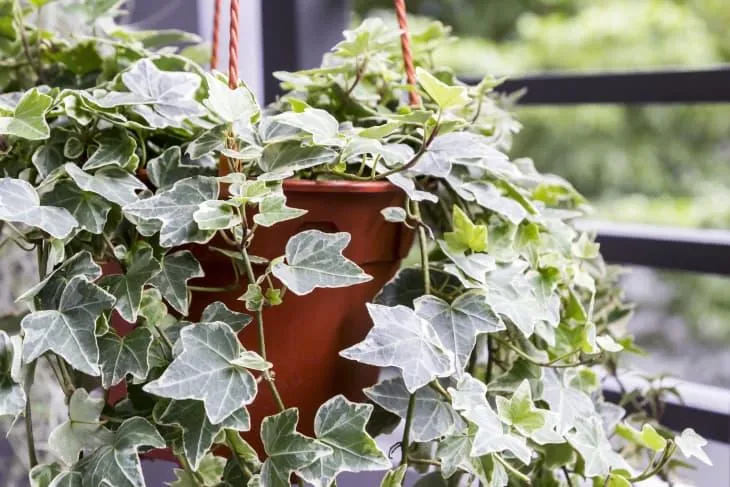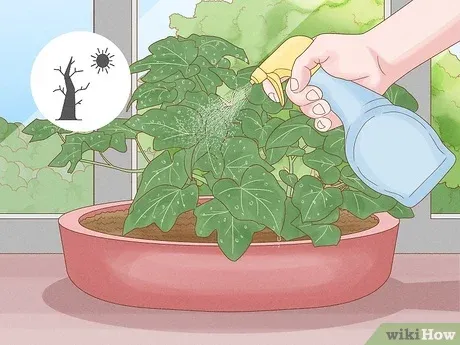A Comprehensive Guide to English Ivy Indoor Plant Care
English ivy is one of the most popular indoor plants for many good reasons. It’s really low maintenance, looks stunning sprawling over walls or furniture, and thrives even in low light areas indoors. But keeping it healthy and happy does require some care – and this guide will walk you through exactly what you need to do.
Understanding English Ivy
English ivy (Hedera helix) is a flowering perennial vine that’s native to Europe and Asia. It’s well-suited to indoor conditions thanks to its ability to tolerate low light and dry air. Ivy uses small rootlike structures called haustoria to cling tightly to surfaces as it grows, allowing it to climb walls, trees, and other vertical supports both inside and out.
Ivy foliage comes in different varieties like plain green, variegated with creamy white or yellow edges, or golden.
Choosing a Plant
When selecting an English ivy plant, go for one with dark green, healthy leaves. Avoid any with yellowing or browning foliage. Make sure the stems and vines are sturdy and not limp or cracked.
You can find ivy sold in pots, hanging baskets, or on plaited vines that are ready to attach right away. Larger, more mature plants will cover more surface area faster than smaller, younger ones. Consider starting with a smaller plant if you’re new to ivy care, to get the hang of it before tackling a big guy.
Light Requirements
English ivy thrives in low to medium light indoor conditions. It can tolerate quite dark areas like north-facing windows. But for optimal growth and to keep foliage colorful if it’s a variegated type, aim for a spot with bright indirect light for at least six hours daily.
Direct sun through south or west-facing windows can scorch ivy leaves over time. I once made this mistake of placing my gorgeous golden ivy in a direct sun window – oops! It dropped half its leaves within weeks. So beware of overexposing it.

Watering Tips
Moisture is key for healthy ivy. Allow the top inch or two of soil to dry out between waterings, then give the plant a good soak until water drains freely from the drainage holes. Feel the soil with your finger to gauge moisture levels.
During warmer months when indoor air is drier, you may need to water every 5-7 days. In cooler seasons, every 10-14 days should suffice. Propagating ivy cuttings in water is kinda fun too – they grow like crazy that way!
Avoid overwatering, which can cause root rot. Underwatering is safer than drowning the poor thing. English ivy is pretty forgiving of brief dry spells between waterings.
Fertilizing Guidelines
Fertilize your ivy monthly in spring and summer with a diluted, balanced houseplant fertilizer to encourage vigorous growth. I like using organic liquid fish fertilizer – the plants dig it. Just water the fertilizer into the soil until it runs through the drainage holes.
Skip fertilizing in fall and winter when ivy growth slows. As with watering, dilute fertilizer to half or quarter strength per the label instructions. Too much nitrogen can scorch foliage.
Controlling Pests
Unfortunately, spider mites can infest ivy. Check leaf undersides for tiny red dots and webbing. Isolate and spray the plant down with a gentle insecticidal soap if you spot mites. Repeat as needed until they’re gone.
Mealybugs sometimes plague ivy too. Their fuzzy white blobs can be hard to spot hiding between leaves! Rub them off firmly with an alcohol-dampened cotton ball. Quarantine infested plants away from others.

Overall, pests are more likely to hit ivy that’s stressed from improper care. Following the water/light/feeding guidelines should help keep mites and bugs at bay.
Pruning and Training Ivy
English ivy is an aggressive climber that will take off up and over any training structure you give it. Use twist ties, string, or plant ties to direct fresh growth where you want it to spread. You can also weave vines in and out of trellises or poles for a fuller look.
Prune off any damaged, diseased, or overly crowded growth as needed with clean scissors. Ivy responds well to selective pruning to shape and spur on new growth. You can even root pruned stems directly in potting soil.
Avoid heavy fall pruning that could put the plant into shock over winter. A couple light trims to shape things up is fine though.
Repotting and Soil
Repot ivy into a slightly larger container only when you notice roots growing out the drainage holes. Use a potting mix specifically for foliage houseplants. Cactus/succulent soil will be too coarse and gritty.
I like adding extra perlite or orchid bark chips to the potting mix for improved drainage. Soggy soil is ivy kryptonite! Terra cotta pots seem to suit it best in my experience.
When repotting, gently tease out the root ball and trim any really matted or circled roots with sterilized pruning shears. Repot firmly in fresh soil, water well, and place in its preferred light conditions.

So in summary, English ivy needs moderate light, consistent moisture without overwatering, regular fertilizer feedings, and occasional pruning or repotting. Follow these guidelines and your ivy will thrive for years!
Let me know if you have any other indoor plant care questions. I’d be happy to share more tips and tricks I’ve learned over the years through trial by error, like adding perlite to ivy soil because it totally helps with drainage. Keeping houseplants happy takes some practice but is totally rewarding. Peace out!
English Ivy Indoor Plant Care
| Light Needs | Medium to bright indirect light is best. English ivy thrives in bright, eastern or northern windows but wilts in hot, western sun. |
| Water | Water when the top inch of soil is dry. Let excess water drain and do not allow the plant to sit in water. |
| Humidity | English ivy appreciates humidity levels between 50-60%. Mist leaves occasionally if air is too dry. |
| Soil | Well-draining potting mix specifically formulated for houseplants. Do not allow the plant to sit in soggy soil for long. |
| Fertilizer | Feed monthly in the spring and summer with a dilute solution of water-soluble houseplant fertilizer. |
| Pruning | Prune as needed to maintain shape and control size. Remove dead or damaged leaves and stems. |
| Temperature | Between 60-75°F is ideal. English ivy can tolerate temperatures down to 50°F for short periods. |
FAQ
-
How much sunlight does english ivy need?
English ivy likes bright, indirect sunlight. It can tolerate low light pretty well but won’t grow as fast without enough sun. South or east facing windows provide good light. West windows get too hot in the afternoon. North windows don’t offer much sun, so supplement with a grow light if it’s in a north window.
-
How often should I water english ivy?
Water english ivy when the top inch or two of soil is dry. Basically, if you stick your finger in the soil and it feels dry, it’s time to water. In warmer months it may need water every 5-7 days but cut back in the winter when it’s less active. Overwatering will cause root rot, so let it dry out between waterings. It’s better to water less than more with ivy.
-
What kind of soil does english ivy need?
Ivy prefers well-drained soil. A potting mix for houseplants works well. It should contain ingredients like peat moss or coconut coir to retain moisture but still allow excess water to drain away quickly. Kind of a Goldilocks mixture – not too wet, not too dry. You can add perlite or vermiculite to improve drainage if the mix you have seems too dense.
-
How do I prune english ivy?
Prune ivy occasionally to keep it bushy and full. Cut 4-6 inches back from the tips of vines that are getting long. This encourages branching. You can also prune to shape the plant or remove curling or leggy growth. Use sharp pruning shears or scissors. Disinfect the blades between pruning different plants to avoid spreading disease. The trimmed sections should develop new leaves quickly.
-
Can english ivy be toxic to pets?
All parts of english ivy contain saponins, which can cause mild to severe gastrointestinal upset if consumed by pets. However, ivy would need to make up a large part of your pet’s diet to cause issues – an occasional nibble should be fine. Keep ivy plants out of reach of cats and dogs that might chew on the leaves. The sap can also cause skin or eye irritation in some animals. Overall, ivy isn’t considered highly toxic but it’s best to keep curious pets away from it as a precaution.

-
Will english ivy grow well in low humidity?
Ivy does prefer higher humidity levels around 50% or above. It can tolerate lower humidity around 30-40% for shorter periods but may drop some lower leaves. Using a pebble tray under the pot increases the humidity around the plant. You can also mist the leaves occasionally. In very dry indoor winter air, the tips may brown and dry out. A humidifier, especially for low humidity basement rooms, can help ivy stay healthier. It’s less fussy in summer when outdoor humidity is greater.
-
How do I propagate english ivy from cuttings?
Propagating ivy from stem or vine cuttings is effortless. Simply remove 4-6 inch cuttings from the parent plant. Strip off lower leaves, leaving the top few intact. Place the cut end in water and wait for roots to form, usually 2-4 weeks. You can increase your odds of success by using a rooting hormone. Once roots are an inch or longer, pot up the new plant in potting mix. Keep the soil moist until it’s established. Before you know it, you’ll have more ivy plants!
